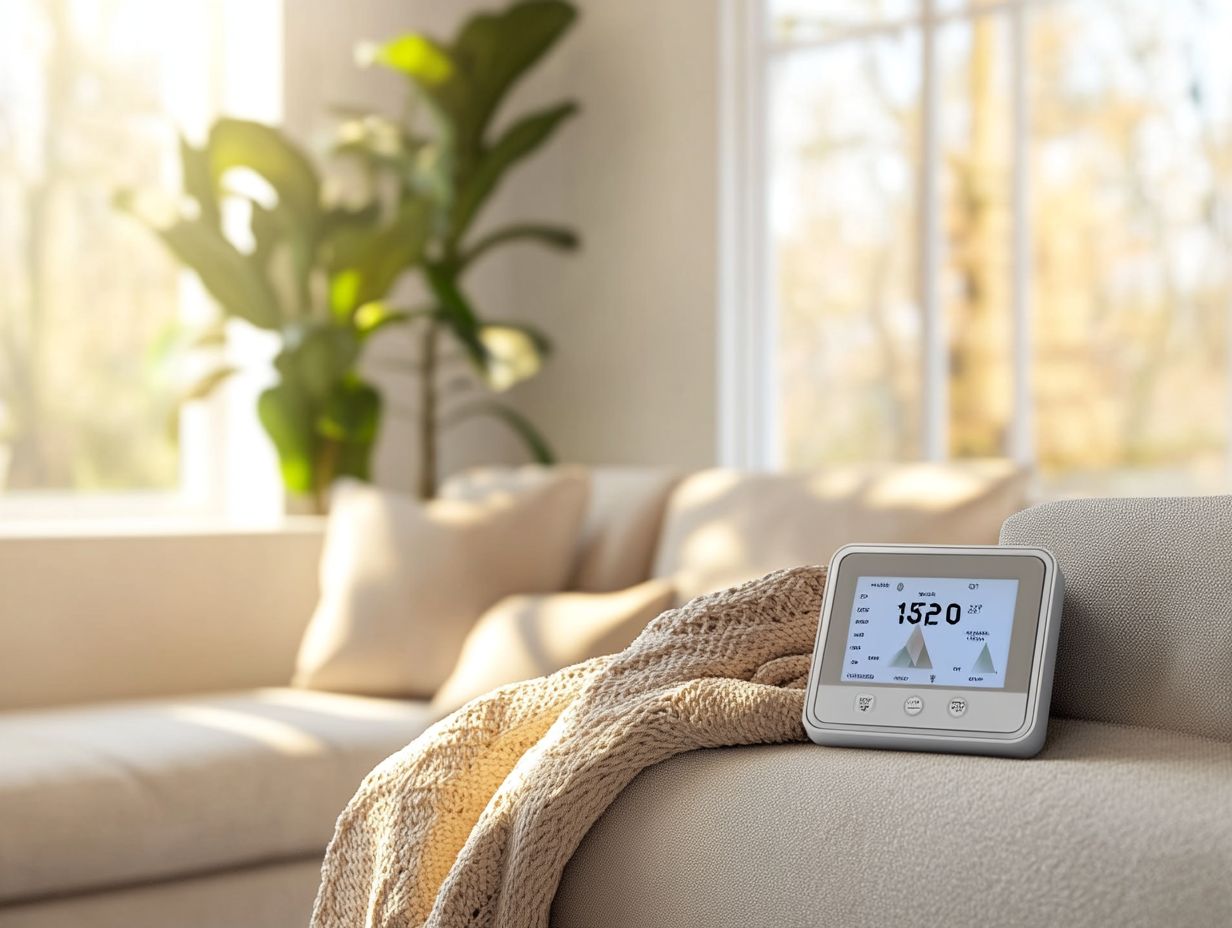How to Manage Temperature Fluctuations
Temperature fluctuations can be quite perplexing and uncomfortable, often leaving you pondering their causes and effects. From sudden shifts in the weather to hormonal changes, medications, and even dietary choices like watermelons, cucumbers, and oranges, a myriad of factors can trigger these variations in your body temperature.
Understanding how these fluctuations influence your physical and emotional well-being is essential for maintaining your overall health. Get ready to explore the causes of temperature fluctuations, their effects on your body, and discover practical strategies to manage them effectively.
Whether you re seeking relief or simply eager to expand your knowledge, continue reading to uncover valuable insights that could enhance your well-being.
Contents
- Key Takeaways:
- What Are Temperature Fluctuations?
- What Causes Temperature Fluctuations?
- Managing Temperature Fluctuations in Your Home
- How Do Temperature Fluctuations Affect the Body?
- How to Manage Temperature Fluctuations?
- 1. Dress Appropriately
- 2. Use Temperature Control Devices
- 3. Stay Hydrated
- When Should You Seek Medical Help for Temperature Fluctuations?
- Frequently Asked Questions
- Managing Temperature Fluctuations: A Comprehensive Guide
- What Causes Temperature Fluctuations and How Can I Manage Them with an HVAC System?
- How to Regulate Room Temperature Using a Smart Thermostat and Zoning System
- Preventing Temperature Fluctuations in Refrigerators and Freezers
- Impact of Temperature Fluctuations and HVAC System Issues on Health
- Effectively Managing Temperature Fluctuations in Large Commercial Spaces
- Additional Factors Contributing to Temperature Fluctuations and the Role of HVAC
Key Takeaways:

- Understand the causes of temperature fluctuations, including weather changes, hormonal changes, medications, and underlying health conditions.
- Temperature fluctuations can affect both the body physically and emotionally.
- To manage temperature fluctuations, dress appropriately, use temperature control devices such as smart thermostats and programmable thermostats, stay hydrated, practice stress management techniques, and consult with a doctor if needed.
Take control of your comfort today!
What Are Temperature Fluctuations?
Temperature fluctuations encompass the shifts in indoor and outdoor temperatures that can significantly impact your comfort, health, and overall well-being. These variations may arise from a variety of factors, such as seasonal weather changes, the performance of your HVAC (Heating, Ventilation, and Air Conditioning) system, including elements like blocked vents and air filters, and even your personal health conditions.
In areas like Ontario, where climate plays a pivotal role, grasping how to effectively manage these temperature fluctuations becomes essential for maintaining a comfortable home while keeping energy bills in check. This knowledge is especially crucial when utilizing HVAC systems that can be enhanced with smart thermostats and regular maintenance, ensuring that your heating and cooling cycles operate efficiently throughout the year.
What Causes Temperature Fluctuations?
Temperature fluctuations can arise from a myriad of factors, including dramatic shifts in weather, hormonal changes, medications, and underlying health conditions. Such variations can lead to discomfort and upset the balance of your home environment, creating a pressing need for effective temperature control solutions.
Internal issues like blocked vents and dirty ducts can worsen temperature instability. Ensuring clean air ducts and maintaining HVAC components is crucial. Homeowners must recognize these influences to ensure optimal air circulation and keep energy bills in check, preventing the excessive costs associated with heating or cooling.
1. Weather Changes
Weather changes rank among the chief causes of temperature fluctuations, impacting both your outdoor and indoor environments significantly. When temperatures swing unexpectedly, your HVAC system must spring into action, consuming energy and affecting your energy bills. If your system isn t properly configured or maintained through regular maintenance, this could lead to discomfort in your home.
By fine-tuning your air conditioning settings and ensuring optimal insulation, you can effectively mitigate these effects and maintain a comfortable living space, no matter what Mother Nature throws your way. Consider utilizing a zoning system to manage different areas of your home.
Extreme weather patterns, whether blistering heat waves or biting cold snaps, can place additional strain on your HVAC system, resulting in heightened operational costs and accelerated wear and tear. This is where smart thermostats and programmable thermostats become invaluable, allowing you to program your system efficiently and automatically respond to changes in occupancy and external temperatures.
Moreover, proper insulation is essential; it prevents significant heat loss during winter and keeps your interiors refreshingly cool during summer. By harmonizing efficient HVAC settings with quality insulation and smart technologies, you can achieve a more stable indoor climate while optimizing energy consumption and trimming down expenses amidst unpredictable weather shifts.
Managing Temperature Fluctuations in Your Home
2. Hormonal Changes
Hormonal changes, especially during pivotal stages like menopause and perimenopause, can profoundly impact your body s temperature regulation. During these transitions, you might experience sudden hot flashes or chills that affect your household’s comfort. By understanding these physiological shifts, you can quickly take charge of your environment to maximize comfort! This may involve making necessary adjustments to temperature control devices like smart thermostats to create a more stable and comfortable atmosphere.
These temperature fluctuations don t just affect your personal comfort; they can ripple through the entire household, making open communication about these changes crucial. You can enhance collective comfort by adopting various strategies, such as selecting the right bedding materials and maintaining consistent indoor humidity levels.
Consider investing in programmable fans or portable air conditioning units for instant relief during those uncomfortable moments. Herbal supplements like black cohosh can also be beneficial. By staying proactive and attuned to these hormonal influences, you have the opportunity to cultivate a nurturing environment that meets the needs of all family members, ensuring that everyone feels at ease, no matter the temperature outside.
3. Medications
Certain medications can lead to temperature fluctuations as a side effect, impacting how you feel in your home environment. For instance, medications like ibuprofen can disrupt your body’s ability to control its temperature, making temperature changes feel uncomfortable. Recognizing the relationship between medications and your personal comfort levels is essential, as it allows you to manage your HVAC (heating, ventilation, and air conditioning) systems, including air conditioners and ductless units, more effectively. This ensures a stable indoor climate for your entire family.
If you’re managing chronic health conditions, you might find that these effects on temperature regulation are even more pronounced. Adapting your home s heating and cooling systems can be a proactive step to ensure that everyone feels comfortable despite any medication side effects. Simple modifications can help maintain consistent temperatures while air purifiers enhance overall air quality.
By creating an environment that caters to the varying needs of your family members, you can significantly enhance everyone’s comfort and well-being, promoting health and happiness within your household.
4. Underlying Health Conditions

Underlying health conditions can significantly exacerbate temperature fluctuations, making it essential for you to understand how your health affects your comfort at home. Conditions like thyroid storm or malignant hyperthermia can lead to serious temperature regulation issues, necessitating enhanced control measures within your living space. Reliable HVAC systems and proper thermostat settings are critical in these cases.
By grasping the relationship between these health conditions and the performance of your HVAC system, you can take proactive steps to maintain a comfortable environment that caters to your specific health needs.
For example, if you have respiratory diseases, you may notice that higher humidity levels exacerbate your symptoms, underscoring the importance of precise humidity control in your HVAC settings. Similarly, if you experience chronic pain, your sensitivity to temperature changes may vary. This indicates that a well-regulated indoor climate can help alleviate discomfort and enhance your overall well-being.
Customizing your HVAC system to accommodate these individual health complexities not only ensures your comfort but also fosters better recovery and an improved quality of life. Simple adjustments like altering thermostat settings, using air purifiers, or incorporating zoned heating and cooling can make a remarkable difference in creating a harmonious home atmosphere tailored to your unique requirements. Including black cohosh as part of your holistic approach can further enhance your comfort.
Take the time to assess your HVAC system or consult a professional for tailored adjustments that will support your unique needs.
How Do Temperature Fluctuations Affect the Body?
Temperature fluctuations can strongly affect both your physical and emotional well-being, influencing your daily mood and energy levels. Physically, you might find yourself experiencing symptoms like fatigue, headaches, or general discomfort.
On an emotional level, these temperature changes can trigger heightened stress and irritability. This dual impact highlights the necessity of maintaining a stable indoor environment through adept management of your heating, ventilation, and air conditioning (HVAC) system!
By prioritizing your home s comfort and being mindful of the energy costs linked to temperature regulation, you can cultivate a healthier living space that enhances your overall quality of life. Utilizing services like ClimateCare in Ontario or Home Climates in Brooklyn can help you manage these costs effectively.
1. Physical Symptoms
Temperature fluctuations can lead to a range of physical symptoms that may disrupt your daily life, from minor discomfort to more severe health issues. You might find yourself grappling with headaches, fatigue, or respiratory problems, especially in spaces where the HVAC systems are not up to par think dirty ducts or an underperforming furnace fan.
Other serious conditions like heat exhaustion, heat stroke, thyroid storm, and malignant hyperthermia could also be exacerbated by poor temperature regulation.
To combat these physical symptoms effectively, a proactive approach to HVAC maintenance is essential for enhancing your home s comfort and overall well-being.
When the indoor climate isn’t well-regulated, you could also suffer from dry skin or allergies, worsened by the dust and allergens that build up in neglected ducts. This scenario underscores the vital link between the efficiency of HVAC systems and the health of those residing within the space. Issues like blocked vents and dirty ducts can exacerbate these problems, reducing overall home comfort.
Regular maintenance, such as cleaning and inspecting your ducts, greatly improves air quality and energy efficiency. By preventing unnecessary temperature fluctuations, a well-functioning HVAC system, including components like the furnace fan, can help you cultivate a stable indoor climate, alleviating discomfort from thermal stress and contributing to a healthier living environment. Ensure your air filters are clean to maintain optimal air circulation and efficiency.
2. Emotional Symptoms
Emotional symptoms resulting from temperature fluctuations can significantly disrupt your daily life, potentially leading to stress, anxiety, or irritability. These emotional responses often intensify in environments where temperature control is inadequate, affecting the overall comfort of your family.
By implementing stress management techniques and optimizing your HVAC system, you can greatly enhance emotional well-being and foster a more stable home environment.
When family members frequently contend with discomfort from unexpected heatwaves or chilly drafts, it can create a ripple effect of tension and discord throughout the household. Each shift in temperature may trigger various emotional responses, impacting interactions and relationships. Companies like Home Climates can help you maintain a more consistent indoor climate, reducing these stresses.
To address these challenges, you can adopt practices such as mindfulness meditation, regular exercise, and open communication, all of which work to bolster emotional resilience. Ensuring that your HVAC systems are not only functional but also efficiently adapted to seasonal changes can lead to improved air quality and temperature stability, ultimately creating a healthier and more harmonious living space for everyone involved.
How to Manage Temperature Fluctuations?
Effectively managing temperature fluctuations involves a nuanced approach that prioritizes your comfort and well-being. You can start by dressing appropriately for the weather and leveraging temperature control devices like smart thermostats.
Staying hydrated also plays a crucial role, as does incorporating stress management techniques into your routine. By embracing these strategies, you can enhance your family’s comfort and cultivate a more stable and enjoyable living environment, no matter how unpredictable the external temperatures may be.
Consider using tools like a smart thermostat or programmable thermostat to better manage your heating cycle and cooling systems.
Don t wait for the next temperature spike! Start implementing these strategies today for a more comfortable home. Contact a local HVAC professional today to ensure your home stays comfortable year-round!
1. Dress Appropriately
Dressing appropriately is a simple yet powerful way to manage the effects of temperature fluctuations on your personal comfort. By wearing layers, you can easily adapt to changing temperatures, ensuring you remain comfortable no matter how unpredictable your environment may be. This approach not only enhances your comfort but also contributes to the overall well-being of your family, as a comfortable individual can positively influence the household dynamic.
Choosing the right materials is key to improving warmth or breathability, depending on the season. For those colder months, reaching for thermal wear or fleece-lined items will provide you with essential insulation, particularly in homes with inadequate insulation. On the flip side, lightweight fabrics like cotton or moisture-wicking options are perfect for warmer temperatures.
Don t underestimate the power of accessories scarves, hats, and gloves can significantly boost warmth during chilly days, ensuring that everyone in your household feels cozy.
When summer rolls around, lightweight layers and UV-protection clothing can help prevent overheating during your outdoor adventures. By selecting the right clothing based on temperature, you can create a nurturing environment that prioritizes comfort, allowing your family to fully enjoy their time together. Being prepared for heat exhaustion and heat stroke is also crucial during extreme temperatures.
2. Use Temperature Control Devices

Utilizing temperature control devices like smart thermostats can revolutionize the way you manage temperature fluctuations in your home. These devices offer you the flexibility to customize settings that align with your personal preferences as well as adapt to external weather conditions, ensuring optimal heating and cooling cycles.
By enhancing the efficiency of your HVAC system, whether through regular maintenance or upgrades like a smart thermostat, you can enjoy reduced energy bills while maintaining a consistently comfortable environment throughout the year.
Smart thermostats, in particular, provide an exceptional level of convenience and control. With the ability to be programmed remotely via smartphone apps, you can effortlessly adjust your home’s climate, even when you’re miles away. Zoning systems and ductless units enhance control over different areas of your home, ensuring optimal family comfort.
When paired with advanced HVAC systems that utilize inverter technology, these devices collaborate seamlessly to ensure even temperature distribution, effectively eliminating those frustrating hot and cold spots.
The integration of such technology not only elevates your comfort but also plays a significant role in boosting energy efficiency. This means you can maintain the perfect atmosphere in your home without excessive energy consumption, all while fostering a more eco-friendly living space.
3. Stay Hydrated
Staying hydrated is essential for managing those pesky temperature fluctuations. Adequate hydration plays a vital role in supporting how your body manages temperature. When you re dehydrated, you might find that physical symptoms related to temperature changes become more pronounced, leading to discomfort and an increased risk of heat exhaustion.
By encouraging your family members to maintain proper hydration, you can cultivate a healthier home environment that promotes overall comfort and well-being. Proper hydration allows your body to regulate internal temperatures efficiently, ensuring it can respond effectively to both hot and cold environments.
It s crucial to drink water regularly, even before that thirst kicks in because, let s face it, thirst is often a late signal of dehydration. Incorporating hydrating foods like juicy fruits and crisp vegetables into your meals can also enhance your fluid intake.
During extreme weather conditions, consider using tools like water reminders or infusing your drinks with delightful flavors to make hydration more enjoyable. Adding juicy fruits like watermelons, cucumbers, or oranges to your diet can also help. Embrace these habits now to dramatically reduce the discomfort associated with temperature extremes and foster a more balanced, pleasant living atmosphere.
4. Practice Stress Management Techniques
Practicing stress management techniques can help cope with emotional symptoms from temperature fluctuations. Mindfulness, meditation, and deep breathing enable emotional stability during uncomfortable weather changes.
By nurturing a calm and supportive environment within your family, you can significantly enhance overall comfort and resilience against the effects of those unpredictable temperature changes.
In addition to these individual practices, fostering open communication within the family is essential. When everyone feels heard and understood, anxiety and stress during extreme weather changes can diminish significantly.
Engaging in activities like family yoga sessions or collaborative cooking not only fosters bonding but also contributes to emotional well-being.
By collectively deciding on comfortable settings, practicing relaxation techniques together, and supporting each other through emotional highs and lows, you create a warm and inviting home atmosphere. Organizations like ClimateCare in Ontario or community resources in Brooklyn can offer additional support and guidance on maintaining a balanced home climate.
This unity not only aids in managing stress but also deepens emotional connections as everyone navigates the challenges posed by temperature shifts together. For accurate weather forecasting and preparedness, you can rely on institutions such as NOAA to help anticipate and manage these fluctuations effectively.
5. Talk to Your Doctor
If you’re experiencing persistent discomfort or emotional symptoms due to temperature fluctuations, don t wait consult your doctor now. They can help rule out any underlying health conditions, such as thyroid storm or malignant hyperthermia, and provide tailored advice or treatment options that address both your physical and emotional needs related to temperature management.
These temperature fluctuations can impact not just your physical health but also your emotional well-being, potentially leading to feelings of anxiety or irritability. Monitoring how your health relates to these temperature changes is vital since effective management can significantly enhance your overall quality of life.
Whether it’s that nagging coldness affecting your mood or the heat causing stress, being aware of these connections can enable you to make informed decisions. Engaging with healthcare professionals allows for the development of personalized strategies, helping you navigate the delicate balance between comfort and wellness, ultimately fostering a more harmonious living space.
Medications like ibuprofen can also help mitigate discomfort.
When Should You Seek Medical Help for Temperature Fluctuations?
Understanding when to seek medical attention for temperature fluctuations is essential for ensuring both your health and the comfort of your family. Services like Home Climates can offer expert advice on managing your HVAC system and maintaining a stable indoor environment.
If you notice that symptoms linger for an extended period, become severe, or disrupt your daily activities, it s wise to consult with a healthcare provider.
If you have underlying health conditions, such as perimenopause or menopause, it s crucial to monitor your symptoms closely to avert any complications related to temperature regulation. Taking proactive steps can make all the difference in maintaining your well-being.
1. If Symptoms Persist for an Extended Period
If you find that symptoms related to temperature fluctuations linger for an extended period, it s crucial to seek medical assistance to uncover any potential underlying issues. Prolonged discomfort might signal more serious health concerns, such as a thyroid condition or the transitional phase before menopause, that necessitate professional evaluation and management.
By being proactive about your health, you can enhance your overall home comfort and well-being. Recognizing these persistent symptoms is key, as they can offer valuable insights into your health status.
It s important to document the specifics of these fluctuations consider the duration, frequency, and any accompanying symptoms to effectively communicate this information to your healthcare provider.
By keeping a clear record, you can ensure that you present a comprehensive picture of your situation during consultations. This thorough communication can assist doctors in making well-informed decisions regarding diagnosis and treatment plans.
Taking these steps fosters a collaborative approach to your health and enables you to proactively manage your well-being. Additionally, regular intake of hydrating foods like watermelons and cucumbers can also support your health in managing temperature fluctuations.
2. If Symptoms Are Severe and Affect Daily Life

Severe symptoms arising from temperature fluctuations that disrupt your daily life should prompt you to seek immediate medical intervention. When discomfort escalates to a point where it interferes with your activities, it s essential to consult a healthcare professional for assessment and potential treatment options.
Timely intervention can be vital in restoring your comfort and ensuring your overall quality of life. Neglecting these signals could lead to more serious health concerns.
For example, if you experience a persistent fever accompanied by chills, dizziness, or severe headaches, it may indicate a more significant underlying issue that demands prompt attention. Similarly, if you find yourself feeling faint or breathless after minimal exertion, don t dismiss it.
Such symptoms can significantly hinder your ability to engage in routine tasks and might require immediate use of HVAC systems to stabilize the indoor environment, affecting both your personal and professional responsibilities.
Acting swiftly not only aids in your recovery but also helps prevent potential complications that could worsen your overall health.
3. If You Have Underlying Health Conditions
If you have underlying health conditions, it s crucial to be especially aware of temperature fluctuations and to seek medical assistance if these changes affect your well-being. Pre-existing conditions can complicate your body s ability to regulate temperature, making it essential to obtain tailored medical advice for effective symptom management.
By prioritizing your health, you can create an environment of comfort and stability for your family at home. These conditions can range from cardiovascular issues to metabolic disorders, each influencing how your body reacts to environmental changes.
For instance, if you have diabetes, you may find yourself more susceptible to hypothermia or hyperthermia due to fluctuations in your blood sugar levels. Similarly, if you suffer from chronic respiratory diseases, maintaining thermal comfort can be a real challenge.
That s why it’s vital for you to engage in proactive health management by consulting healthcare providers. Together, you can develop personalized strategies that cater to your unique needs, possibly involving a smart thermostat for better home temperature regulation.
This not only promotes better health outcomes but also strengthens your collaborative relationship with medical professionals, ultimately enhancing your overall wellness.
Frequently Asked Questions
Stay vigilant with your health. If you notice concerning symptoms, reach out to your healthcare provider today!
Managing Temperature Fluctuations: A Comprehensive Guide
What Causes Temperature Fluctuations and How Can I Manage Them with an HVAC System?
Temperature fluctuations can arise from various factors, including weather changes, faulty equipment, and inadequate insulation. Blocked vents, dirty ducts, and clogged air filters can also play a significant role. Regularly monitoring and adjusting your heating and cooling systems, sealing air leaks, and ensuring proper insulation in your home or workspace are essential steps for effective management.
How to Regulate Room Temperature Using a Smart Thermostat and Zoning System
Regulating room temperature can be easily achieved with a programmable or smart thermostat, which allows you to set temperature levels at different times of the day. Utilizing window coverings to block sunlight helps keep the room cooler, and fans can circulate air for added comfort. A zoning system effectively regulates temperature in different areas of your home.
Preventing Temperature Fluctuations in Refrigerators and Freezers
To prevent fluctuations in your refrigerator or freezer, keep the doors closed as much as possible and avoid overloading the units with food. Regularly cleaning the condenser coils ensures they are not blocked, which can lead to the units working harder and experiencing temperature variations.
Impact of Temperature Fluctuations and HVAC System Issues on Health
Extreme temperature fluctuations can negatively affect your health. Constantly transitioning between hot and cold environments can stress your body and weaken your immune system, making you more prone to illness. Problems within your HVAC system, such as blocked vents or a malfunctioning furnace fan, can worsen these effects. Managing temperature fluctuations is crucial for maintaining a comfortable and healthy living environment.
Effectively Managing Temperature Fluctuations in Large Commercial Spaces
In large commercial spaces, having a well-maintained HVAC system that meets the demands of the area is critical. Regular maintenance and inspections can identify and resolve issues causing temperature fluctuations, like blocked vents and dirty ducts. Implementing zoning in heating and cooling systems enhances temperature regulation throughout different areas, while ductless units also assist in efficient temperature management.
Additional Factors Contributing to Temperature Fluctuations and the Role of HVAC
Aside from weather and equipment, building materials, ventilation systems, and even human activity such as frequently opening and closing doors can contribute to temperature fluctuations. Properly utilizing an HVAC system with regular maintenance and clean air ducts is essential for effective temperature management. It s vital to consider all these factors when addressing temperature fluctuations in any space.






